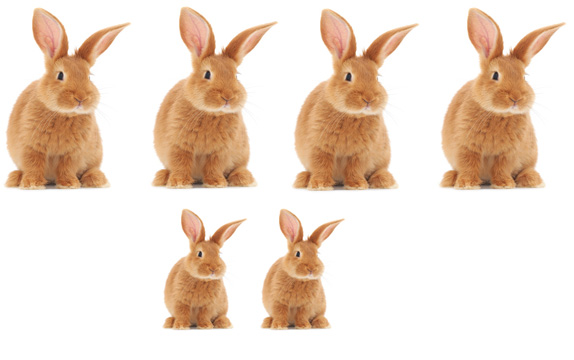
The Fibonacci sequence: A brief introduction

Leonardo Fibonacci c1175-1250.
The Fibonacci sequence
$$1, 1, 2, 3, 5, 8, 13, 21, 34, 55, 89, ...$$ is one of the most famous number sequences of them all. We've given you the first few numbers here, but what's the next one in line? It turns out that the answer is simple. Every number in the Fibonacci sequence (starting from $2$) is the sum of the two numbers preceding it: \begin{eqnarray*} 2 & = & 1 &+& 1 \\ 3 & = & 1 &+& 2 \\ 5 & = & 2 &+& 3\\ 8 & = & 3 &+& 5, \end{eqnarray*} and so on. So it's pretty easy to figure out that the next number in the sequence above is $55+89 = 144,$ and (in theory at least) to work out all numbers that follow from here to infinity.Where does it come from?
The Fibonacci is named after the mathematician Leonardo Fibonacci who stumbled across it in the 12th century while contemplating a curious problem. Fibonacci started with a pair of fictional and slightly unbelievable baby rabbits, a baby boy rabbit and a baby girl rabbit.

They were fully grown after one month

and did what rabbits do best, so that the next month two more baby rabbits (again a boy and a girl) were born.

The next month these babies were fully grown and the first pair had two more baby rabbits (again, handily a boy and a girl).

Ignoring problems of in-breeding, the next month the two adult pairs each have a pair of baby rabbits and the babies from last month mature.

Where does it go?
Real rabbits don't breed as Fibonacci hypothesised, but his sequence still appears frequently in nature, as it seems to capture some aspect of growth. You can find it, for example, in the turns of natural spirals, in plants, and in the family tree of bees. The sequence is also closely related to a famous number called the golden ratio. To find out more read The life and numbers of Fibonacci.
About the author
Rachel Thomas is Editor of Plus.
Comments
Anonymous
5 occupies position number 5 in the Fibonacci sequence.
The number that occupies the 25th position, 75025, ends with 25 (which is 5^2 of course).
The125th position is occupied by a number ending in 125 (or 5^3): 59425114757512643212875125.
Ditto for 625 and 3125, which are 5^4 and 5^5 respectively
But this curious rule seems to start breaking down for powers of 5 greater than 5.
Anonymous
Now let's pretend 5 is the first Fibonacci number instead of the usual 1, but still use the same addition algorithm: 5 5 10 15 25. That 25 is of course 5 squared.
Try this with 4 however: 4 4 8 12 20, and we don't land on 4 squared. 16 isn't in the sequence generated. The same goes for 6: 6 6 12 18 30 48 doesn't include 36. But then 4 and 6 aren't in the Fibonacci sequence either.
In fact the only start numbers we can hit the square with seem to be the Fibonaccis and no others:
1
2 2 4
3 3 6 9
5 5 10 15 25
8 8 16 24 40 64
13 13 26 39 65 104 169
etc etc.
(My treatment of 1 seems a bit anomalous here since although it 's a perfect square, I haven't presented it as the result of any addition. This can be remedied perhaps with: 0 1 1)
Note also the number of numbers in each sequence, which is equal to the position of the start number in the standard Fibonacci sequence. For example 13 takes 7 numbers to get to its square, and 13 occupies position 7.
Lastly although I came across these results concerning Fibonacci powers on my own (see also my previous comment about 5), I daresay they aren't new discoveries. So please tell me of any similar work.
Rachel
Hi Chris,
Your conjecture that you only get to the square of the start number if it's one of the original Fibonacci sequence is lovely! I wonder if anyone can come up with a proof?
R
Anonymous
I liked it too at first, Rachel, but now I realise it's not so exciting after all, since it says nothing about Fibonacci numbers in particular unfortunately.
Take any random collection of numbers that includes 1. Beginning with 1, line them up in otherwise any way you like. Tell someone it's a "sequence" and that they are to multiply each successive number (including the 1) by any one number already there in the sequence. Obviously they're going to generate a new sequence which includes a number which is a perfect square of the first. For example 1 23 7 13 4 5 each multiplied by 4 is going to result in 4 92 28 52 16 20. That's effectively all I did in multiplying each item in the standard Fibonacci 1 1 2 3 5 8 by 8 for example to get 8 8 16 24 40 64 without spotting its triviality at the time.
Anyway I'm very pleased you had a look. I still hope my other results in this thread are interesting, especially the quantitative and structural differences in sequences resulting from varying the maturation delay. See "Fibonacci's fast and slow breeders". I'd be grateful for your opinion.
Chris G
Anonymous
Yes, Fibonacci made certain assumptions, as we all do when figuring out what to expect. But is it fair of Rachel to describe them as a "highly unbelievable breeding process"?
True, he ignores potential in-breeding problems and mortality, but this isn't unduly optimistic given that he asked what quantity of rabbits could be expected at the end of only 12 months. And the birth of two babies of the same sex to one adult pair could be offset by two of the opposite sex being born to another.
What Fibonacci does refrain from assuming is a geometric population expansion such as 1 pair the first month, 2 the second, 4 the third, and so on. At 12 months this would lead to 2048 pairs of rabbits, compared to Fibonacci's much more modest 144. This is because he builds in a highly realistic maturation delay right from the start: 1 pair the first month, and still just one pair the second month. Only with the third do we have two pairs (two adults and two babies), 3 pairs the fourth month (the first pair of adults with another pair of babies, but the second generation still without issue). That second generation first produces its own pair in the fifth month along with yet another pair from the first two rabbits, making 5 pairs altogether, and so on.
Asking how many pairs after 12 months seems reasonable given our custom of yearly progress reviews. However the answer 144 must have intrigued Fibonacci the mathematician, as it does us today, since it is of course 12 squared.
I investigate this matter of powers in the Fibonacci sequence a bit more in my two previous comments, Fib 5 and Hitting that Square.
Chris G
Candace
Male rabbits are not sexually mature until a minimum of 4 months and females a minimum of 6 months.
Anonymous
I've already observed how restrained Fibonacci rabbits are in their reproducton rate, due to the maturation delay (MD) of two months before producing their first offspring in the third. I've been constructing some of those well known family tree type diagrams for varying MD values: 1 month, 2 months (the Fibonacci case), 3 and 4. They seem to yield the following twelve-item sequences:
For MD = 1 month: 1 2 4 8 16 32 64 128 256 512 1024 2048 A simple doubling at each stage as every rabbit pair produces another in the second month of life. Fast.
2 months: 1 1 2 3 5 8 13 21 34 55 89 144
3 months: 1 1 1 2 3 4 6 9 13 19 24 31 The addition algorithm is a bit more complicated than for the familair Fibonacci one. It involves some leapfrogging (or should I say leapbunnying): 1 + 1 = 2, 1 + 2 = 3, 1 + 3 = 4, 2 + 4 = 6, 3 + 6 = 9, 4 + 9 = 13 and so on.
4 months: 1 1 1 1 2 3 4 5 7 10 14 19 Here we add each pair of numbers separated by two in between: 1 + 1 = 2, 1 + 2 = 3, 1 + 3 = 4, etc. Note that 10 is both the rabbit quantity and month number, just as 5 is for the Fibonacci case, so maybe the same sort of results as I observed before in "Fib 5".
OK I know my comments to Rachel's stimulating article have been proliferating like, well, you know what. That's just because they've been conceived and born with corresponding spontaneity.
Chris G
Anonymous
Hi Rachel. This is to continue our interesting discussion about a result with squares I'd thought I'd found in the Fibonacci sequence (see below). This time compare some of the sequence to the left as well as the right of 0 with a corresponding segment of the famous Lucas sequence:
Fibonacci: . . . 34 -21 13 -8 5 -3 2 -1 1 0 1 1 2 3 5 8 15 21 34 . . .
and
Lucas: . . . 47 -29 18 -11 7 -4 3 -1 2 1 0 3 4 7 11 18 29 47 . . .
The Lucas can be seen as resulting from swapping round two consecutive Fibonacci terms, from 2, -1 to -1, 2 while retaining the same addition rule as Fibonacci, adding two consecutive numbers to get the third as you go right. To the right in the Lucas we now have not just one but two integer squares, those of -1 and 2, namely 1 and 4, in the Lucas. Hmm? Well, let's do the Lucas swap elsewhere in the Fibonacci to be a bit more convincing. What about from 13, -8 to -8, 13 (and get a different sequence because we're keeping to the same addition rule)?
. . . -8 13 5 18 23 41 64 85 169
Do you think this result escapes the charge of triviality that I felt bound to level at my first attempt to hit the square? Do you feel it's twice as lovely? I do for the moment, but am always ready to reconsider.
Chris G
Anonymous
There shouldn't be a 0 in the Lucas sequence.
Chris G
Chris G
The last sequence should have 105, not 85, as the penultimate number in the last sequence. I do wish I could spot errors before hitting the save button. Anyway, at least it doesn't affect my point, which is that 64 and 169 are squares of -8 and 13 respectively.
Tika
can anybody answer this question?
Modify Fibonacci’s rabbit problem by introducing the additional rule that rabbit
pairs stop reproducing after giving birth to three litters. How does this assumption
change the recurrence relation? What changes do you need to make in the simple
cases?
Chris G
It doesn’t look as if PlusMaths is going to post my first answer. Just as well, since it was wrong, so here’s my second attempt.
I printed off the biggest Fibonacci rabbit family tree diagram I could find on the net, showing 10 monthly generations resulting in a population of 55 pairs. I subtracted from each monthly population total those rabbit pairs which can't exist that month if each pair stops breeding after producing 3 litters. I entered the new sequence 1 1 2 3 5 7 11 16 24 35 into OEIS and got (amongst others) A023435 which followed on with 52 76 112 164 241 ...
The new recurrence relation, given by OEIS, is a(n)= a(n-1) + a(n-2) - a(n-5). Note that n=5 is the last index at which the Fibonacci and this new sequence continue to share terms. It marks the third and last time the first rabbit pair produces offspring.
The main problem I can see is OEIS also calls this sequence "Dying rabbits". That seems to negate the question, which assumes all rabbits once born continue to live and figure in the subsequent monthly population totals indefinitely. As I'm sure I only crossed off those which couldn't have been born, not those who simply stopped reproducing, this name appears to be wrong.
no name
if you had 2 bunnies at the start you would have 18,454,930 rabbits after 3 years.
Jack Davis
Clever buggers, rabbits. They can have two pregnancies going at once - one on the back-burner. Allows them to get through lean times and still reproduce with a minimum of mating. Sort of damages their promiscuous reputation though! I suspect I haven't contributed value to the mathematical discussion. I respect the discussion, but it hurt my head trying to follow it.
Chris G
You seem to be referring to the original Fibonacci sequence, term 35.
If you meant to reply to my post, then the number of rabbit pairs at this stage if they produce only 3 litters each is 504,355, or only 1,008,710 individuals.
It's still a lot though.
A Middle Schooler
Your rabbits are really well pictured :)
captain_no_underpants
are there other versions of the rabbit problem
eden
okay so what if i had a model of the number of pairs of rabbits up to
30 time periods but then i wanted to modify the model so that in the fifth period of life the rabbits cease to produce offspring and in the next period they die
Rivfader
I didn't know that about bee family trees. That's very interesting because it seems legitimate, and actual instances of the Fibonacci sequence in nature and art are more few and far between than people think. For instance, Fibonacci spirals are not especially common. Your source never claims that they are found in nature; it just makes the extremely weak claim that spirals are found in nature. This has nothing to do with the Fibonacci sequence unless they are Fibonacci spirals, so that section should be omitted if you ask me.
Chris G
In fact they've been known to cannibalise each other. Well, that famous variant on the Fibonacci sequence, known as the Lucas sequence, can be used to model this. It goes 2 1 3 4 7 11 18 29 47 76 and so on, but like Fibonacci adding each successive two numbers to get the next.
For our rabbits this means start with 2 pairs and one eats the other, so now only 1. However that 1 then gives birth to 3. Of those 3, 1 gives birth to 2, but the other 2 don't give birth yet, so now we have 4. Next the 2 that didn't give birth last time now give birth to 3 each, while of the remaining 2, one eats the other, leaving us with a total of 7. And so on.
Heather P
Each die is a standard 6-sided cube, but the six faces bear the first six numbers of the Fibonacci sequence, 1, 1, 2, 3, 5, and 8. If this pair of dice is rolled once, what is the probability that the sum of the numbers showing on the top faces of the two dice is a Fibonacci number?